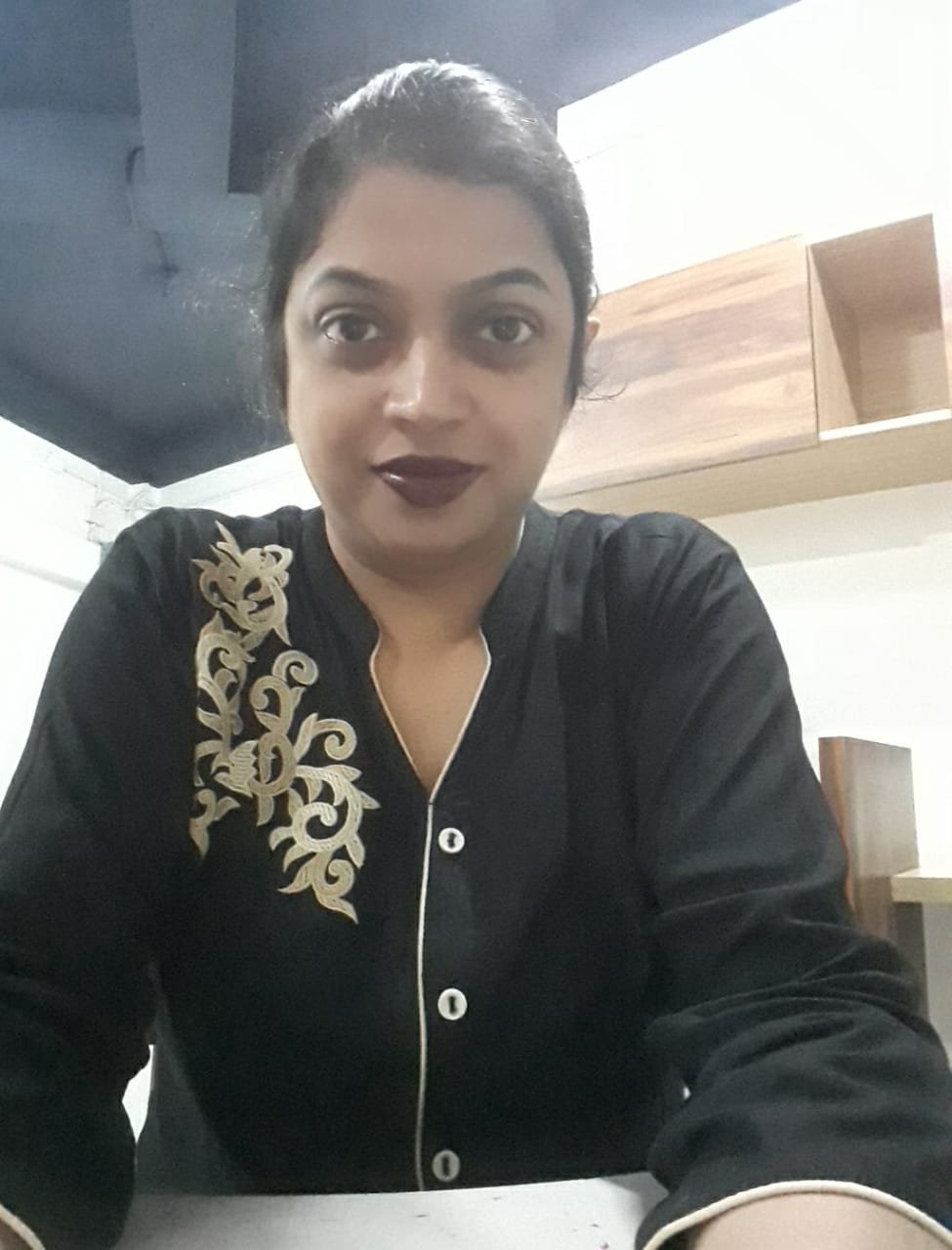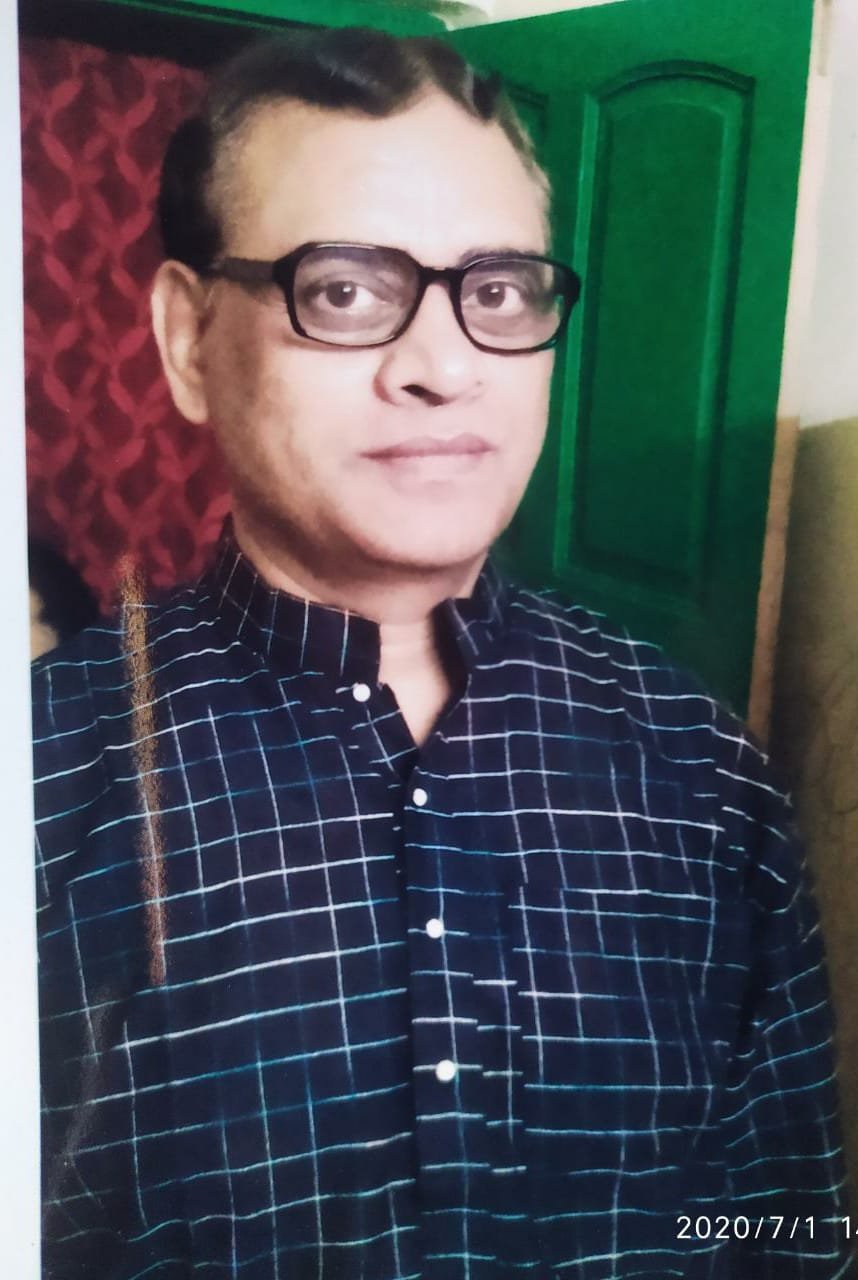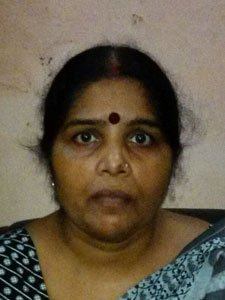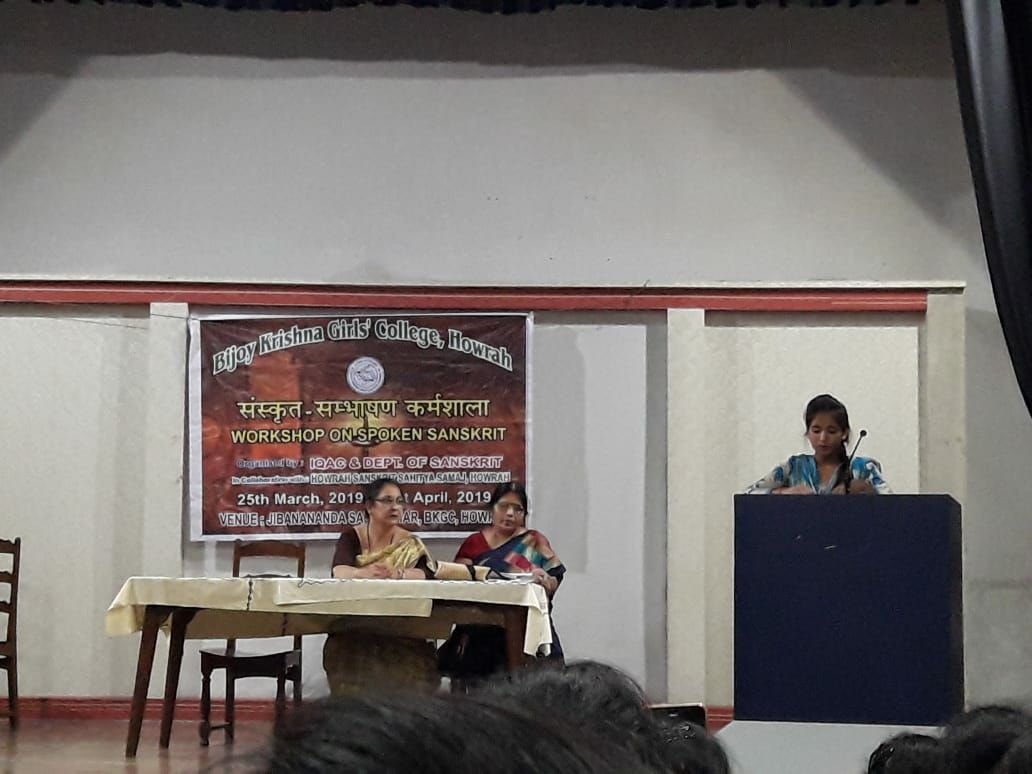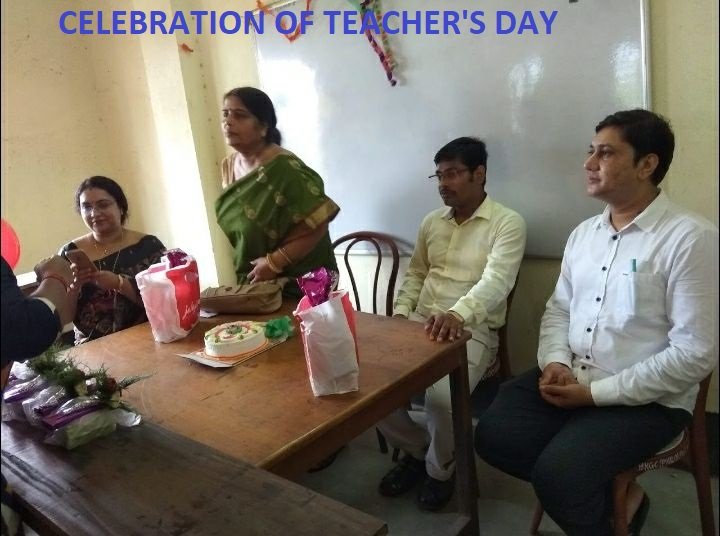About
-
History of Dept:- i )Established in 1947 with Honours
ii) Opened PG course in 2015
-
Mission & Vision:- Missions:
-
To develop our students skill in different areas of the subject.
-
To enhance our students capability in Spoken- Sanskrit
-
To motivate them in computerisation in Sanskrit
Visions:
-
To motivate them in different field of research
-
To publish a departmental journal with peer review
-
To organize a workshop on Manuscript & Palaeography
3. Notable Alumni:-
-
Dr Aditi Bhattacharya; Assistant Professor in Sanskit College & University
-
Naznin Choudhury; Assistant Professor in Jhargram Raj College
-
Purnima Halder ; Research Scholar
-
Tithi Majhi; Assistant Teacher in Govt School of Howrah
-
Sudipa Das , Techer of Zee school
-
Departmental Infrastructure:-
-
2 UG rooms
-
2 PG Rooms
-
2 Seminar libraries
-
1 Laptop
-
Future Plan:-
-
To conduct students workshop on Manuscriptlogy, Palaeography & Spoken Sanskrit
-
To organize extension lectures
Programmeout come:
After completion of UG curriculum specially taking Honours in Sanskrit Literature a student can plan for her/his future as follows-----
-
Can move for further higher studies like Masters in Sanskrit, Pali&Prakrit, and Buddhist Studies etc.
-
Can join diploma courses in Manuscriptology.
-
Can study or prepare for WBCS, IPS and IAS, PSC examinations or any other Govt. or non Govt. job.
-
After completion of Masters can move for NET/SET examination
-
Go for research work like M. Phil, Ph.D
-
After passing NET/SET can go for college teaching
-
After completion of Masters/Graduations can join for B. Ed & M. Ed course and move for school or college teaching.
7. Course Outcome:
CC 1:
Sec A –Raghuva??am – Written by Kalidasa, this epic narrates the tale of Dilipa, a righteous Ikshvaku king who undertakes a pilgrimage to the sage Vashistha’s ashram in order to beget a son. This text provides extensive information about the duties and responsibilities of an ideal king and life in ashramas.
Sec B- Kum?rasambhavam- This epic by Kalidasa recounts the penance performed by Parvati in her quest for Shiva. The importance of penance and perseverance in achieving one’s goal, and the triumph of substance over superficial beauty are highlighted here in.
Sec C- Kir?t?rjun?yam- One of the earliest texts dealing with espionage and intelligence gathering. This epic by Bharavi describes a spy’s account of Duryodhana’s rule over Hastinapur to Yudhisthira.It deals extensively with the principles and best practices of ruling over a kingdom.
Sec D- N?ti?atakam- This text by Bhartrihari is a compilation of a hundred verses dealing with ethical behavior, rules and social norms.
Sec E- Origin and development of Mahakavya and Gitikavya- We learn the works and literary style of Asvaghosa, kalidasa, Bharavi, Magha, Bhatti, Sriharsa, Jayadeva, Bhartrhari and Amaru.
CC2:
SecA- Vedic Literature- A study of vedicliterature provides invaluable insights into our culture and the Hindu way of life. Moreover research has demonstrated that the phonetics of vedic mantra has roots in various energy points of the body and reciting these mantras stimulates these points and raises energy level.
Sec B- R?m?ya?am- One of the largest epic in world literature, the Ramayanam helps us comprehend significance of relationships and provides a vivid portrayal of the ideal relationship. It also renders ethical and philosophical teachings fundamental to the Hindu cultural consciousness.
Sec C- Mah?bh?rata- The Mahabharata is the longest epic in the world. Among other things it contains devotional and philosophical material central to the ancient culture. It also makes us aware of the four goals of life and the importance of work.
Sec D- Pur??as- Particularly dealing with legends and other traditional lore, the Puranas are known for their intricate layers of symbolism. They provide us with vital information about myriad subjects such as grammar, medicine, cosmology etc.
Sec E – General introduction to Vy?kara?a, Dar?ana, S?hitya-??stra-Vyakarana is the backbone of any literature. Sanskrit vyakarana is most powerful and effective among all languages. Most of the world literature have taken something from Sanskrit vyakarana. It has highest number of vocabularies. A sound understanding of grammer serves to strengthen our grasp over various linguistic structures. In this section we also learn different school of Indian philosophy and six major school of Indian poetics.
CC 3:
Sec A?ukan?sopade?a- In this part of Kadambari social and political thoughts of Banabhatta has been depicted.
Sec B- R?jav?hanacaritam- Poetic excellence of Dandin is at its peak in this prose.
Sec C-Origin and development of Prose- The Panchatantra illustrates the central Hindu principles of Niti . It highlights the importance of practical pedagogy and the pivotal role played by a teacher.
CC 4:
Sec A-G?t?: Cognition and emotive apparatus- The Gita expounds upon the nature of the Mind and the role of Atman. It also discusses the three Gunas vis-à-vis their impact on the mind.
Sec B- G?t?: Controlling the mind Confusion and conflict- The Gita describes the various causal factors of conflict and the means of controlling the mind. The importance of discipline balanced life and diet control as well as thinking clearly are impressed upon us.
Sec C-G?t?: Self-management through devotion- The Gita instruct us to acquire moral qualities and abandon frivolous debates with highlights the significance of surrendering one’s ego towards achieving self-management.
CC-5, Sec-A
Svapnav?savadattam-The plot of the drama is drawn from the romantic narratives about the Vatsa king Udayana and Vasavadatta, the daughter of Pradyota, the ruler of Avanti, which were current in the poet's time and which seem to have captivated popular imagination. The main theme of the drama is the sorrow of Udayana for his queen Vasavadatta, believed by him to have perished in a fire, which was actually a rumour spread by Yaugandharayana, a minister of Udayana to compel his king to marry Padmavati, the daughter of the king of Magadha.
will help students to-
i) enhance ability to read and understand Sanskrit,
ii) understand and explain the contemporary relevance and utility of Indian society depicted in this drama and also know the sacrifice of Indian woman for her husband and nation,
iii) critically assess existing research through careful reading analysis and discussion.
Sec- B+C:
Abhijnanashakuntala, (Sanskrit: “The Recognition ofShakuntala”) drama by Kalidasa composed about the 5th century CE that is generally considered to be the greatest Indian literary work of any period. Taken from legend, the work tells of the seduction of the nymph Shakuntala by King Dushyanta, his rejection of the girl and his child, and their subsequent reunion in heaven.
-
Students will have advanced command on Sanskrit language, through advanced text reading and basic knowledge in Prakit, Sanskrit,
-
Students can acquire capacity to appreciate the need to have alternative perspectives in Sanskrit,
-
Students can take the knowledge about inter-cast marriage, female education, duties of good housewife, police system, penalty of thief, revenue system, law of inheritance of ancient Indian society and it can be useful for multi-disciplinary research on history and socio-economic life,
-
This drama will remind the student the importance of nature in human life.
Sec-D àCritical Survey of Sanskrit drama:
-
This section aims to get students acquainted with the journey of classical Sanskrit drama from pre-Kalidasa to post-Kalidasa period,
-
It aims to provide information to the students about the life of dramatists and their works, like, Bhasa, Kalidasa, sudraka, Visakhadatta, Sriharsa, Bhavabhuti, Bhattanarayana, and students can understand the spread and influence of Sanskrit drama and culture through the ages in various parts of India.
CC-6 àPoetics and literary criticism:
Sec-A àIntroduction to Sanskrit poetics
-
Students can acquire knowledge about the origin and development of Sanskrit poetics,
-
This section displays a working knowledge of the various names of Sanskrit poetics,
-
Students can understand concept of definition, objective and causes of poetry,
-
Effectively communicate ideas related to the poetic works during class and group activities.
Sec-B àForms of Kavya-literature
-
This section aims the students to learn the classification of poetics,
-
Analyze literary works for their structure and meaning,
-
Identify and describe distinct literary characteristics of poetic forms.
Sec-C àSabdashakti and Rasa Sutra
-
Students can learn about the function of word and meaning, denotative meaning, indicative meaning and suggestive meaning,
-
Students can evaluate major theory of Rasa-Sutra of Bharata and its prominent expositions and the transcendental nature of Rasa (as discussed in Kavyaprakasa).
Sec-D àFigures of Speech and Meter
Students can learn about the general introduction of Indian Petrology and the definitions, nature and classification of various arthala?k?ra and ?abdala?k?ra (according to S?hityadarpa?a X and Chandamañjar?).
CC-7 à Indian social Institutions and Polity:
Sec-AàIndian Social Institutions: Nature and Concepts
Students will know about:
-
The sociological definitions of social institutions, from Vedic to classical literature and also from Buddhist and Jain literature and inscriptions of foreign writers,
-
The different kinds of dharma in the sense of social ethics.
Sec-B àStructure of Society and Values of Life
Students will apprehend the knowledge about:
-
The four-fold division of Var?a-System, division of Var?a according to Gu?a and Karma, origin of Caste System from Inter-caste Marriages,
-
The position of women in different stages of society,
-
The social relevance of Indian lifestyle with special reference to sixteen Sa?sk?ras.
Sec-C àIndian Polity: Origin and Development:
Students will be able to understand the concepts of:
-
Sabh?, Samiti, Vidatha, R?jakart?rah, Ratnin, Coronation ceremony of Samr??, Republic States in the Buddhist Period from ?atapathabr?hma?a, Digghanik?ya, Mah?parinirbba?a Sutra, A?guttaranik?ya, ?gveda, Atharvaveda,
-
The concept of welfare state, essential qualities of a king, constituent elements of Jain Polity, relevance of Gandhian thought in Modern Period with special reference to Saty?graha Philosophy.
Sec-D àCardinal Theories and Thinkers of Indian Polity:
Students will be able to assess the knowledge about:
-
Sapt??ga Theory of State, Ma??ala Theory of Inter-State Relations, ???gunya Policy of war and peace, CaturvidhaUp?ya for Balancing the power of State and three types of State powers,
-
The life and works of Manu, Kau?ilya, K?mandaka, ?ukr?c?rya, Somadeva Suri, Mahatma Gandhi.
Sec-A-1
Competence in presenting academic writing and oral presentation skills.
-
Students would be able to translate and retranslate simple/compound sentences in Sanskrit as well as in English.
-
Students would comprehend any unknown text and able to write small answers from them.
-
They can express their thoughts and ideas in simple Sanskrit.
-
Write and speak in grammatically correct way.
5.They can write formal and informal letter in Sanskrit- which may help them to acquire job in Sanskrit libraries and also somewhere old letters preserved as documents.
CC-8 àIndian Epigraphy, Palaeography and Chronology:
Sec-AàEpigraphy
Students will be able to understand:
-
The termology of epigraphy and types of inscriptions,
-
The contemporary relevance and utility of studies of inscriptions in the reconstruction of Ancient Indian history and culture,
-
How the Kharos?i and Br?hm? script was deciphered and contribution of scholars in the field of epigraphy.
Sec-B àPalaeography
Students will be able to apprehend:
-
The origin of early Indian script, development of the script,
-
The palaeographical methods and analysis and classification of distinct styles of writing.
-
Information about writing materials, inscribers and library.
Sec-C àStudy of selected Inscriptions
Students will accumulate knowledge from selected inscriptions like Giran?ra Rock edict, Giran?ra inscription, Eran pillar inscription, Khalimpur copperplate, etc.
Sec-D àChronology
Students will be able to get attached with Archaeology and Museumology by knowing about:
-
System of dating of inscriptions,
-
Main eras used in insciptions.
CC-9àModern Sanskrit Literature:
Sec-A àMah?k?vya and Charitak?vya
Students will gain knowledge about the modern Sanskrit kavyas by Sanskrit writers and the simplicity of the Sanskrit language in modern writings.
Sec-B àGadya and R?pakas
Students will know about Gadyas and R?pakas.
CC-10 àSanskrit World Literature:
Sec-A
Students will learn about the contributions of western scholars (like Max Müllar, William Jones) in the field of Sanskrit studies.
Sec-B
Students will learn about the contributions of Indian pioneers (like Swami Vivekananda, Sri Aurobindo, Day?nandaSarasvat? to modern Scholars like Roma Choudhuri, Ramaranjan Mukherjee).
Sec-C àSanskrit Fables in World Literature
Students will know about the influence of Sanskrit fables (Pañcatantra, Vet?lapañcavi??atik? etc.) in world literature.
Sec-D
Students will gain knowledge about:
-
the influence of R?m?ya?a and Mah?bh?rata in South-eastern Asia,
-
Mah?bh?rata stories as depicted in folk cultures of South-eastern Asia.
Sec-E àK?lid?sa in the West
Students will acquire the capacity to appreciate the need to learn about the English and German translations of K?lid?sa‘s works in aspect of western literature and theatre
Sec-F àSanskrit Studies across the World
Students will acquire the capacity to validate the popularity of Sanskrit studies across the world.
Sec-B-2:Competence in presenting academic writing and oral presentation skills.
-
Students would be able to translate and retranslate simple/compound sentences in Sanskrit as well as in English.
-
Students would comprehend any unknown text and able to write small answers from them.
-
They can express their thoughts and ideas in simple Sanskrit.
-
Write and speak in grammatically correct way.
-
They can write formal and informal letter in Sanskrit- which may help them to acquire job in Sanskrit libraries and also somewhere old letters preserved as documents.
CC-11
Sec A- Vedic Literature- Students are pursuing the course of Vedic Texts endowed her to develop a critical perspective to assess existing research through careful reading ,analysis and discussion. The students can take the knowledge about the classification of veda, socio economic life of the Aryans , women education ,teacher and taught relation and philosophical importance.
Sec B- Vedic Grammar- The students would know Vedic Grammar and also know the differences between classical and Vedic Grammar.
Sec C- Br?hma?a and Upani?sad- The students would know about the Brahamana texts and its importance.
The course acquiring the knowledge about holistic spirits, self- confidence and secular attitude and logical mind.
DSE -1: Dar?ana
Students would be able to know that how we know the worldly things ,& what is the importance of Indian philosophy and contribution of Shankaracharya in the field of Indian philosophy.
CC-12
SEC-A: General Grammar
•Student can produce the sanskrit verb- phrases themselves, and they will know the importance of traditional grammar.
•Students would be able to translate simple Bengali- sentences into Sanskrit languages, and would be able to use the traditional lexicon.
•Students would be able to understand the system of traditional grammar.
SEC-B: General Introduction of Philology
•This course of linguistics will be increase the knowledge about descriptive , morphological and hypo logical classification of languages.
•The student would know about the nature of spoken Vernacular sanskrit, different phonetic and morphological changes of the words.
Section -c: K?rakaprakara?amvaiy?kara?Siddh?ntaKaumud?
• This course will be increase the sense of grammar and develop their systematic knowledge, because the knowledge of grammer is a pillar of languages.
• Help gaining proficiency in Sanskrit language.
• It give holistic and comprehensive understanding of the subject.
• Understanding the syntax and rules of Sanskrit language.
Section -D: Sam?saprakara?am
Vaiy?kara?aSiddh?ntaKaumud?
•This course help to develop the concept of the specific method of grammar according to the Perspective of BhattojiDiksita’sSiddhantaKaumudi.
• To familiarize students about compound constructions of Sanskrit words.
• Be able to realize the internal and external factors of influence for greeting poetry.
DSE 2( K?vya)
SEC-A
S?hityadarpa?a chapter- 1,2 ,3
•Students would know about the definition and importance of Kavya from different perspective.
• Thery learn many notable works of Criticism combine discussion of text with broad arguments about the nature of literature and principles of assessing it.
CC- 13 (Indian ontology and epistemology ):
SEC A- Essentials of Indian Philosophy
•The students would know about the history of Indian philosophy.
• Evaluate the major theory of ‘Astika’ and ‘Nastika’ philosophy. The students could relate the philosophical theory in practical life.
•This course aims to get the students acquainted with the Indian principles of debate and its application not just in philosophical dialogue, but in every walk of knowledge.
SEC B- Ontology (Based Tarkasa?graha?)
•A conceptual perspectives that human behaviors and actions are largely determined by stimuli which are not off their own making.
•The relevance of the emergence of debate for philosophical activity in India.
SEC C- Epistemology(Based on Tarkasa?graha?)
•The significance of epistemology in Indian Philosophy and the sense in which religion is involved in it.
•An attempt to extract some intercultural aspects of the history of Indian Philosophy.
DSE-3 Vy?kara?a:
SEC A-Sidh?ntakoumud? -str?pratyaya
• Learning the sanskrit Grammar they clearly communicate in sanskrit.
• Learning the proper grammar they express their thoughts and ideas.
• They can write and speak correctly.
•They gain the knowledge of stripratyaya.
SEC B-Sidh?ntakoumud?Tinantaprakarana(√bhu)
•This course enables the students to learn and acquire the Advance knowledge of Derivational process of the sanskrit Verbal Morphology based on the sidhantakoumudi.
SECC- Siddh?ntakaumud? Ajanta Pu?li?ga
•They can write and speak correctly.
•They gain the knowledge of Ajanta Pumlinga.
•Analyzing the Paninian Grammar.
CC- 14 Sanskrit Compilation and communication:
SEC A-Vibhaktyartha, Voice and K?t.
•This paper enables the students to know about the sanskrit grammatical traditions. It also deals with the derivational process of the words ending with primary Suffiixes (Krit )
Base andSidhantakoumudi.
SEC B-Translation and Communication
•Students would be able to translate simple Bengali sentences in to Sanskrit Languages,
And would be able to use the traditional Lexicon.
•Realizes the value of language diversity.
•Motivated to learn new Languages.
SEC C-Essay
•The students could learn to write essay in sanskrit language and also learn how to summarize a passage.
•The course is to expose students to the rich and profound tradition of creative writing in sanskrit. Also enriched by new genres of writing.
DSE- 4(Veda)
SEC-A-Eastern and western interaction of the Veda / ?una??epop?khy?na of AitareyaBr?hma?a.
•This course acquiring the knowledge about holistic Sprils, self confidence and Secular attitude and logical mind.
•The student would know about the Brahamana text and it’s importance.
SEC-B-Taittiriyopani?ad?ik?avally/Mu??akopani?ad
•Philosophical text ‘Mundakopanisad’ will be developing the philosophical sense of the students. •Develops self-control, moral values and Social Ethics.
•Becomes a self motivator and initiates hermony.
PG Course Outcome
Semester -1
Course Code: SANS MA CC 1
Course Title: Veda: From this portion students can learn different types of Vedic Hymns and also able to learn the theological aspects of Veda.
Course Code: SANS MA CC 2
Course Title: Grammar: This part helps the students to know the higher grammar of Paniniyam which helps them to build up their grammatical knowledge and sense of writing in Sanskrit.
Course Code: SANS MA CC 3
Course Title: Darsana: In this portion orthodox Indian philosophy is taught from where they can grasp philosophical knowledge.
Course Code: SANS MA CC 4
Course Title: Sahitya: This section taught the utility of poetry by which students can learn aesthetic concept.
Course Code: SANS MA CC 5
Course Title: Cultural heritage of India & Vedic Studies: From this portion students are taught eastern and western views and cultural heritage of India along with Upanisads and Vedic grammars by which they can build up a clear concept in Vedic studies.
Semester -2
Course Code: SANS MA CC 6
Course Title:P??in?yavy?kara?a: Siddh?ntakaumud? (Sandhi, Prakr?tibh?va and Relating to the formation of ajantapu?glinga, srilinga, napu?sakali?ga)
Course outcome- This section will help students to acquire the following skills-
-
Advanced knowledge and understanding of Paniniyan School of grammar, related to euphonic combination, morphologywithPaniniyan aphorism.
-
Advanced command of Sanskrit Language through advanced text reading and text editing.
-
Ability to critically assess any text written in Sanskrit language or existing research through careful reading. Also, by unfolding the inner meaning of an unknown word of a text using grammatical strataandunveiling the author’s intension, which can be useful for any future research work.
Course Code: SANS MA CC 7
Course Title:Darsan: Bh?s?pariccheda with general acquaintance with Mukt?val? (anum?nakha?da) and Arthasamagraha (Purvam?m??s? text).
Course outcome- This section will help students to-
-
know about the history of Indian Philosophy
-
Evaluate the major theory of Nyaya and m?m??s?. Also, relate the philosophical theory in practical life.
Course Code: SANS MA CC 8
Course Title:Sahitya: Dhany?loka- A work articulating the philosophy of aesthetic suggestion (dhvanivy?ñjana) written by ?nandavardhana.
Course outcome-
-
Dhvani theory- According to P. V. Kane this book (Dhany?loka) is an epoch-making work in history of Ala?k?ra Literature. Hence students will apprehend the modern approach of ancient poetics and can do a comprehensive study or research work on the soul or essence of poetry.
-
Will help to enhance students’ basic analytical & critical thinking and communicative competencies.
-
Through S?hityadarpa?a students can know- variety of Rupaka, definition of N?taka, character of N?yaka and N?yik? in various Rupaka, what is to be shown in a drama or not, vast knowledge about performing a Rupaka in ancient stage etc.
Course Code: SANS MA CC 9
Course Title:Veda
Course outcome-
-
?atapathabhahma?a, taittir?yabrahmana: Vedas, the oldest sacred writing of India- The brahmanas are later exegetical (explanation of religious text) text where students can know the proper performance of rituals in Vedic period.
-
Through Pañcamah?yajña a student can know the ancient people- their respects to the elders, hospitality given to guests, feeding the poor animals, which are parts of mah?yajña, largely missing in common people today.
-
Through vidy?pra?ams? students can learn the proper way to gain real knowledge.
-
Nirukta: Students will know most of the rare and obscure Vedic words by the various possible etymologies.
-
Also understand the real significanceof a particular word that has been used in specific mantras.
-
They will acquire the knowledge of systematic creation of glossary.
-
Students will also know the classification of the deities according to the three regions, earth, sky and heaven, as described in the Nirukta, which is essential for the advanced Vedic studies.
Course Code: SANS MA CC 10
Course Title: Grammar & Philology: In this portion students are taught higher Sanskrit grammar and descriptive and historical linguistics, development of linguistics and philological development of IE sounds.
Semester -3
Course Code: SANS MA CC 11
Course Title:Darsana: In this portion different types of Indian philosophical topics are explained by which a student can be able to learn advanced knowledge in Indian orthodox philosophy.
Course Code: SANS MA DSE SH 1
Course Title:Sahitya DSE 1: Here comparative aesthetics with its relationship to the development of Rasa theory has been discussed along with two such poetics.
Course Code: SANS MA DSE SH 2
Course Title:Sahitya DSE 2: Here Natyasastra&Ramayanachampu are taught. From Natyasastra students can learn verity of stages and other important topics regarding drama or stage performances and from Ramayanachampu they know peculiarities of Champu literature as well as the story.
Course Code: SANS MA DSE SH 3
Course Title:Sahitya DSE 3: Here two major epic has been taught by which they can know the style of the both composers of these epics as well as the story of the epic and its poetic excellence.
Semester 4:
Course Code: SANS MA CC 12:
Course Title:Sahitya: 1) Ratnavali- Attributed to the Indian Emperor Harsha,Ratnavali is a Natika in four Acts.It provides valuable insights into the exigencies of court life and contains one of the first textual references to the celebration of Holi. It is one of the most important Sanskrit Natikas, and finds extensive mention in the Dasarupaka.
2) Dhvanyaloka- Anandavardhana’sDhvanyaloka is a pivotal work in the history of Indian poetics which revolutionized Sanskrit literary theory by declaring Rasa as the primary goal of poetry. It highlights the fact that the evocation of Rasa can be expounded by recognizing a semantic influence beyond metaphor and denotation viz. the influence of suggestion.
Course Code: SANS MA DSE SH 4
Course Title:Sahitya DSE 4: 1) Uttararamacarita-Bhavabhuti’s magnum opus Uttarramacarita is a Nataka in seven Acts. It is arguably the finest example of the use of Karuna Rasa and provides readers with a plethora of historical and social knowledge of the time, especially in relation to marital relations.
2) PrabodhaCandrodaya – Written by Krishna Mishra in the eleventh century, PrabodhaCandrodaya is an allegorical drama which emphasizes the advaita philosophy. It intends to teach the advaita doctrine primarily to those interested in Kavya.
Course Code: SANS MA DSE SH 5
Course Title:Sahitya DSE 5: 1) Harshacharita- Harshacharita marks the beginning of historical poetic works in Sanskrit. Written by Banabhatta in an ornate style, it provides graphic descriptions of rural India’s natural environment and the structure of the society at that time.
2) Meghaduta – One of Kalidasa’s most famous works, Meghaduta is the pre-eminent specimen of the Mandakrantametre. It gave rise to the genre of SandesaKavya, and is celebrated for its richness of content and power to evoke sentiment. It makes the readers aware of the importance of duty.
Course Code: SANS MA DSE SH 6
Course Title:Sahitya DSE 6: 1)Mricchakatika- Attributed to Sudraka, Mricchakatika is one of the most significant Prakaranas in Sanskrit Literature. Rife with comedy, romance, intrigue and politics, Mricchakatika provides invaluable insights into the socio-political conditions of the time.
2) Mudrarakshasa– Written by Vishakhadatta, Mudrarakshasa is a Nataka which emphasizes on Chanakya’s political strategies and methods. It contains a vivid portrayal of practices germane to espionage which were employed by Chanakya to serve his purposes.


